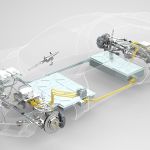Kia used CES 2024 to reveal its PBV (Platform Beyond Vehicle) future strategy, featuring an all-new modular vehicle lineup, led by the Concept PV5. It was presented alongside a multi-phase plan that will help advance Hyundai Motor Group (HMG) ambitions in robotics, AAM (advanced air mobility), and autonomous driving.
Kia said its PBVs are part of a total mobility solution that combines fit-for-purpose EVs with advanced software solutions based on the Hyundai Motor Group’s software-to-everything (SDx) strategy. With the PBVs, Kia aims to open the door to new businesses and lifestyles by redefining the concept of space thanks to advanced, tailored interiors that provide ultimate freedom and flexibility.
Indicating the importance of the CES launch to Kia was the presence of execs like Pierre-Martin Bos, Vice President and PBV Director, of Kia Europe; Ho-sung Song, President and CEO, of Kia Motors Corp.; and Karim Habib, Executive Vice President and Head, of Kia Global.
“Kia PBVs will be an enabler of business innovation thanks to our customer-centric management system, EV mass production expertise, and the Hyundai Motor Group’s rapidly developing SDx strategy and related future businesses,” said Ho-sung Song. “We are excited to show that we are fully prepared to become the first mover in the global PBV market.”
The brand’s PBV roadmap is divided into three phases.
Phase one will see the introduction of the PV5, an EV optimized for major domains such as ride-hailing, delivery, and utilities that features conversion capability for diverse customer needs. It allows passengers to customize the vehicle’s interior according to their preferences, tastes, and application requirements. Enhanced data connectivity between vehicles and external data such as route or delivery information will enable the convenient operation of multiple vehicles as a software-defined fleet. Kia said this emergence of tailored business fleets and PBV-specific solutions means less downtime and enhanced cost-effectiveness.
Phase two will see the completion of the dedicated PBV lineup, with models evolving into AI-based mobility platforms that use data to interact with users and ensure that vehicles are always up to date. An integrated solution is intended to provide a seamless experience across devices and software. Meanwhile, new forms of business linked with robotics and other future technologies will emerge.
In phase three, the PBVs will evolve into highly customizable, bespoke mobility solutions by integrating with the future mobility ecosystem. Kia said its PBVs will ultimately become life platforms that turn any inspiration into reality. Connected self-driving vehicles will be managed as part of a single smart city operating system. With the emergence of a hyper-connected world where people, PBVs, and social infrastructure are seamlessly linked, the company intends to open the door to completely new lifestyles by creating a robust ecosystem based on the Hyundai Motor Group’s future technologies for autonomous driving, advanced air mobility, robotics, and the energy grid.
Using Easy Swap technology to address the diverse demands of customers, a single vehicle chassis can be used to fulfill multiple mobility needs. Behind a fixed cab, or driver zone, a variety of interchangeable upper bodies, or life modules, can be connected to the base vehicle via a hybrid electromagnetic and mechanical coupling technology, turning the PBV into a taxi during the day, a delivery van at night, and a personal recreational vehicle on weekends.
In line with phase one of the PBV strategy, various versions of the PV5 will be available including basic, van, high roof, and chassis cab versions. In the future, Kia also plans to introduce a robotaxi model developed with Motional, the joint venture between HMG and Aptiv.
During phase two, the PBV ecosystem will be complemented by PV7 and PV1 models using cabinet and frame systems to enhance interaction and connectivity among vehicles based on the modular concept. The PV7 concept, the largest product in the new lineup, is defined by more interior space, greater driving range, and enhanced functionalities. PV1, the smallest vehicle in the lineup, is designed for agile and short-distance logistics transportation, using driving modules and four-wheel steering to minimize turning radius, even in narrow spaces.
An integrated rail system on the vehicles’ ceiling, floor, and side panels, as well as on the exterior, enables modularity and customization of the vehicle to meet individual customer needs. This system enables a seamless transfer of goods and items between vehicles using cabinets and frames. The rails within this ecosystem simplify the movement of items between vehicles, while the modular design of the tiles and functional accessories, such as speakers and shelves, offer flexibility for a wide range of scenarios.
“Kia PBVs will initiate a new era of seamless everyday business and lifestyle solutions,” said Habib. “We hope to make our customers’ lives easier and better, whether they’re stationary or on the move, offering exceptional flexibility and customization through radical modularization.”
The Kia brand’s solutions for IVI (in-vehicle infotainment), FMS (fleet management system), and charging will leverage vehicle-software-based data and AI (artificial intelligence) technologies, further enabling customer-centric solutions, predictive maintenance suggestions to minimize downtime, and charging programs tailored to the customer’s business operating environment.
Kia’s FMS for PBVs allows customers to oversee multiple vehicles. It provides insights on sales, inventory, and deliveries, benefiting mobility and logistics businesses. Features include inventory monitoring, temperature control, and intelligent route planning for efficiency. The solution streamlines fleet management with real-time data and AI integration for predictive maintenance and optimal operational efficiency.
- Kia PBV concept lineup: PV1, PV5, and PV7.
- Execs (L to R) Pierre-Martin Bos, Ho-sung Song, and Karim Habib launched Kia’s PBV business at CES.
- Kia PV1 and PV7 concept docking.
- Kia PBV concept design by Dong Joo-Kim.
- Kia PV5 concept with Boston Dynamics’ Spot.
- Kia PV5 interior.
























































































